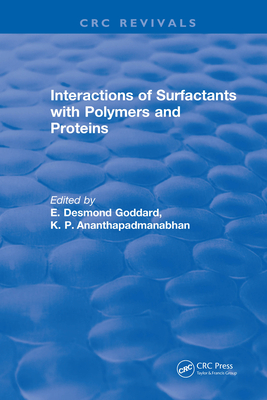Read Online Interactions of Surfactants with Polymers and Proteins - E.D. Goddard file in ePub
Related searches:
Interactions of Surfactants with Polymers and Proteins - 1st
Relative roles of surfactant interactions with proteins and lipids in
Surfactant Definition and Examples
How Do People Interact With Their Environment?
Interaction with Industry
Surfactants: physicochemical interactions with biological
Interactions between surfactants and hydrolytic enzymes
(IUCr) The role of protein and surfactant interactions in membrane
Interaction of Dyes with Cationic Surfactants in Solutions
Anionic Surfactant and Heavy Oil Interaction during Surfactant
Interactions between DNA and gemini surfactant: impact on gene
Interactions between Ionic Surfactants and Polysaccharides in
Polymer-Surfactant Interactions and the Association Behavior
Interactions between Hydrophobically Modified Polymers and
Intermolecular Interactions in Polyelectrolyte and Surfactant
3161 4846 1490 3302 4371 4132 1732 2486 1117 3302 2470 3022 384 3952 4565 601 3236 4388 1614 3186 2247 252 2761 454 2646 3121 4613 1051 1504
Interactions of sulforhodamine b or ethyl eosin (as the anionic dye) with cetylpyridinium bromide (as a cationic surfactant) have been investigated by visible.
Biopolymer surfactant interactions 441 as ctab with a positively charged headgroup. Such behavior is uncommon and very interesting from both the biophysical and biotechnological points of view. In solutions of nonionic surfactants, such as tween 80-tween 60 mixtures, solubilization of gelatin was too low to form an organogel.
Ideally, the nature of interactions between nonionic surfactants and proteins can best be described through thermodynamic drivers, such as changes in enthalpy and entropy, in relation to properties (polar, charged, or hydrophobic) of regions on the surfactant and protein molecules themselves.
The law of interaction is the name given to sir isaac newton's third law of motion, which holds that an interaction between two objects brings creates an equal and opposite reaction.
In this paper, protein and lipid interaction tendencies of 10 commonly used surfactants are presented and the results are correlated with their in vivo skin drying.
From the viewpoint of interactions between surfactants and cellulosic solid materials, it is expected that anionic surfactants will display minimal affinity with the respective surfaces.
Apr 22, 2019 coinjecting of steam with surfactant to recover heavy crude oil is studied. Performance production of this process is achieved through analysis.
Behavior of hmhec and its interactions with ionic and nonionic surfactants. We have used a fluorescence technique [3 j with pyrene as a probe. In addition to conventional viscosity and surface tension methods, to investigate the as-sociation of hydrophobic groups on the polymer as well as their interactions with surfactant molecules.
The scientific study of protein surfactant interactions goes back more than a century, and has been put to practical uses in everything from the estimation of protein molecular weights to efficient washing powder enzymes and products for personal hygiene.
By choosing ionic surfactants and pairing them with polyelectrolytes, formulations can make use of hydrophobic, electrostatic, or a combination of both interactions. The interactions of polymers and surfactants can be understood through their association behavior.
Sustainability efforts exist to help humans co- people react to their environment in a variety of ways.
Jan 19, 2016 gemini surfactants alone or in a mixture with helper lipids have exhibited enhanced transfection efficiency; however, the interaction mechanism(s).
Mw) -- interactivecorp is broadening its online travel emporium. Mw) -- interactivecorp is broadening its online travel emporium. The owner of the popular travel site expedia said monday that it's buyin.
There are 17 disease interactions with lyllana (estradiol): major potential hazard, high plausibility.
Attractive protein–detergent complex (pdc) interactions were observed as the surfactant cloud-point temperature was approached for each salt, suggesting that.
From these polymers and surfactants, six combinations of polymer−surfactant are made: mc−sds, mc−ctab, cs−sds, cs−ctab, kc−sds, and kc−ctab. The polymer−surfactant interactions for the six pairs are systematically investigated by isothermal titration calorimetry (itc).
In the surfactant concentration range varying from 0 to 100 mm, sds exhibited electrostatic binding to the charged groups of the polypeptide chain resulting in considerable reduction in the hydrodynamic radius (rh) of gelatin up to the critical association concentration (cac), and at higher concentrations both the sds micelles and gelatin−sds complexes were found to be coexisting in equilibrium.
Hydrolytic enzymes are combined with surfactants in many types of formulations, for instance detergents and personal care products. If the surfactant interacts with the enzyme there may be conformational changes that eventually lead to loss of the enzymatic activity.
We continue to monitor covid-19 cases in our area and providers will notify you if there are scheduling changes. We are providing in-person care and telemedicine appointments.
Mineral-surfactant interactions for minimum reagents precipitation and adsorption for improved oil recovery.
Interactions between the anionic dye acid orange 7 and two cationic surfactants n- cetylpyridinium chloride (cpc1) and cetyltrimethylammonium bromide.
An important number of macromolecules are present in mixtures with surfactants, where a combination of hydrophobic and electrostatic interactions is responsible for the specific properties of any solution. It has been demonstrated that surfactants can help the formation of helices in some proteins thereby promoting protein structure formation.
Studies on the folding mechanism of the outer membrane protein a (ompa) in surfactants. Although the interactions of surfactants with membrane proteins is very.
Interactions of surfactants with polymers and proteins provides a wealth of information for chemists involved in a number of different research areas, including cosmetics, pharmaceutics, foods, paints, pigments, lubrication, ceramics, minerals/materials processing, and biological systems.

Post Your Comments: